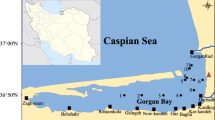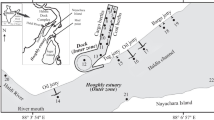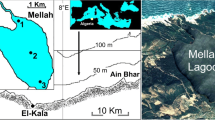Abstract
Phytoplankton community was investigated during two contrasting periods using offshore plankton samples in the volcanic area of Methana peninsula (Saronikos Gulf): the first at early autumn (warm period, September 2016) and the second one at early spring (cold period, March 2017). In order to investigate the phytoplankton community structure in the complex geo-biochemical conditions of the area, samples were collected from stations near the CO2 hydrothermal vents, at the hydrothermal sulfur and radioactive springs and at a fishery nearby Methana town. Three major phytoplankton groups, Bacillariophyceae, Dinophyceae, and Prymnesiophyceae, were studied, using inverted microscopy. In early autumn, Dinophyceae were dominant in the majority of the stations with cell concentrations of Prorocentrum spp. up to ~ 35.5 × 103 cells l−1. In early spring, the dominant class was Bacillariophyceae with dominant genus Nitzschia/Pseudo-nitzschia presenting cell concentrations up to ~ 33.9 × 103 cells l−1. Furthermore, Prymnesiophyceae appeared in both spring and autumn samples with small fluctuations. Total phytoplankton cell concentrations followed a seasonal trend, presenting slightly lower values in the hydrothermal-effected area in comparison with the broader Saronikos Gulf, confirming the prevalence of oligotrophic conditions. Seasonal variation was very strong, revealing an association with water temperature and nutrient content. Those environmental variables proved to have a strong effect that was reflected in the phytoplankton community structure.





Similar content being viewed by others
Data availability
The datasets used and/or analyzed during the current study are available from the corresponding author on reasonable request.
References
Abrantes N, Antunes SC, Pereira MJ, Goncalves F (2006) Seasonal succession of cladocerans and phytoplankton and their interactions in a shallow eutrophic lake (Lake Vela, Portugal). Acta Oecol 29(1):54–64
Alongi DM, McKinnon AD, Brinkman R, Trott LA, Undu MC, Muawanah R (2009) The fate of organic matter derived from small-scale fish cage aquaculture in coastal waters of Sulawesi and Sumatra, Indonesia. Aquaculture 295:60–75
Baggini C, Salomidi M, Voutsinas E, Bray L, Krasakopoulou E, Hall-Spencer JM (2014) Seasonality affects macroalgal community response to increases in pCO2. PLoS One 9(9):e106520. https://doi.org/10.1371/journal.pone.0106520
Cao J, Hou Z, Li Z, Chu Z, Yang P, Zheng B (2018) Succession of phytoplankton functional groups and their driving factors in a subtropical plateau lake. Sci Total Environ 631-632:1127–1137
Caroppo C, Buttino I, Camatti E, Caruso G, De Angelis R, Facca C, Giovanardi F, Lazzara L, Mangoni O, Magaletti E (2013) State of the art and perspectives on the use of planktonic communities as indicators of environmental status in relation to the EU Marine Strategy Framework Directive. Biol Mar Mediterr 20(1):65–73
Caroppo C, Cerino F, Auriemma R, Cibic T (2016) Phytoplankton dynamics with a special emphasis on harmful algal blooms in the Mar Piccolo of Taranto (Ionian Sea, Italy). Environ Sci Pollut Res 23:12691–12706
Caroppo C, Roselli L, Di Leo A (2018) Hydrological conditions and phytoplankton community in the Lesina lagoon (southern Adriatic Sea, Mediterranean). ESPR 25(2):1784–1799
Carroll ML, Cochrane S, Fieler R, Velvin R, White P (2003) Organic enrichment of sediments from salmon farming in Norway: environmental factors, management practices, and monitoring techniques. Aquaculture 226:165–180
Cerino F, Malinverno E, Fornasaro D, Kralj M, Cabrini M (2017) Coccolithophore diversity and dynamics at a coastal site in the Gulf of Trieste (northern Adriatic Sea). Estuar Coast Shelf Sci 196:331–345
Chust G, Allen JI, Bopp L, Schrum C, Holt J, Tsiaras K, Zavatarelli M, Chifflet M, Cannaby H, Dadou I, Daewel U, Wakelin SL, Machu E, Pushpadas D, Butenschon M, Artioli Y, Petihakis G, Smith C, Garçon V, Goubanova K, Le Vu B, Fach BA, Salihoglu B, Clementi E, Irigoien X (2014) Biomass changes and trophic amplification of plankton in a warmer ocean. Glob Chang Biol 20(7):2124–2139
Cornwall CE, Revell AT, Hall-Spencer JM, Milazzo M, Raven JA, Hurd CL (2017) Inorganic carbon physiology underpins macroalgal responses to elevated CO2. Sci Rep 7:46297. https://doi.org/10.1038/srep46297
Cruzado A, Velasquez ZR (1990) Nutrients and phytoplankton in the Gulf of Lions. northwestern Mediterranean. Cont Shelf Res 10(9-11):931–942
Edler L, Elbrächter M (2010) The Utermöhl method for quantitative phytoplankton analysis. In: Karlson et al (eds) Microscopic and methods for quantitative phytoplankton analysis, 55th edn. UNESCO IOC Manuals and Guides, Paris, pp 13–20
Eppley RW, Reid FMH, Strickland JDH (1970) The ecology of the plankton off La Jolla, California, in the period April through September 1967. Bull Scrip Inst Oceanogr 17:33–42
Fabry VJ, Seibel BA, Feely RA, Orr JC (2008) Impacts of ocean acidification on marine fauna and ecosystem processes. ICES J Mar Sci 65:414–432
Friligos N (1989) Hydrographic and plankton variability in the Saronikos Gulf. Toxicol Environ Chem 24:155–170
Gao Y, Yin K, He L, Harrison PJ (2012) Phytoplankton growth on organic nutrients from trash fish. Aquat Ecosyst Health Manage 15:234–240
Gilabert J (2001) Seasonal plankton dynamics in a Mediterranean hypersaline coastal lagoon: the Mar Menor. J Plankton Res 23(2):207–218
Glibert PM, Burkholder JM, Kana TM (2012) Recent insights about relationships between nutrient availability, forms, and stoichiometry, and the distribution, ecophysiology, and food web effects of pelagic and benthic Prorocentrum species. Harmful Algae 14:231–259
Hallegraeff GM (2010) Ocean climate change, phytoplankton community responses, and harmful algal blooms: a formidable predictive challenge1. J Phycol 46(2):220–235
Hammer O, Harper DAT, Ryan PD (2001) PAST: Paleontological Statistics Software Package for Education and Data Analysis. Palaeontol Electron 4(1):9pp
Hays GC, Richardson AJ, Robinson C (2005) Climate change and marine plankton. Trends Ecol Evol 20:337–344
Ignatiades L (1969) Annual cycle, species diversity and succession of phytoplankton in lower Saronicos Bay. Aegean Sea, Mar Biol 3:196–200
Ignatiades L, Karydis M, Moschopoulou N (1980) Report on physical, chemical and biological parameters of Saronikos Gulf, during 1980. Greek Atomic Energy Commission, Athens, p 16
Ignatiades L, Vassiliou A, Karydis M (1985) A comparison of phytoplankton biomass parameters and their interrelation with nutrients in Saronicos Gulf (Greece). Hydrobiologia 128:201–206
Ignatiades L, Karydis M, Vounatsou P (1992) A possible method for evaluating oligotrophy and eutrophication based on nutrient concentration scales. Mar Pollut Bull 24(5):238–243
Ignatiades L, Psarra S, Zervakis V, Pagou K, Souvermezoglou E, Assimakopoulou G, Gotsis-Skretas O (2002) Phytoplankton size-based dynamics in the Aegean Sea (Eastern Mediterranean). J Mar Syst 36(1-2):11–28
Ignatiades L, Gotsis-Skretas O, Pagou K, Krasakopoulou E (2009) Diversification of phytoplankton community structure and related parameters along a large-scale longitudinal east-west transect of the Mediterranean Sea. J Plankton Res 31(4):411–428
Jiang YJ, He W, Liu WX, Qin N, Ouyang HL, Wang QM, Kong XZ, He QS, Yang C, Yang B, Xu FL (2014) The seasonal and spatial variations of phytoplankton community and their correlation with environmental factors in a large eutrophic Chinese lake (Lake Chaohu). Ecol Indic 40:58–67
Jiang Z, Liao Y, Liu J, Shou L, Chen Q, Yan X, Zhu G, Zeng J (2013) Effects of fish farming on phytoplankton community under the thermal stress caused by a power plant in a eutrophic, semi-enclosed bay: induce toxic dinoflagellate (Prorocentrum minimum) blooms in cold seasons. Mar Pollut Bull 76:315–324
Kontoyiannis H (2010) Observations on the circulation of the Saronikos Gulf: a Mediterranean embayment sea border of Athens, Greece. J Geophys Res 115(C6). https://doi.org/10.1029/2008JC005026
La Rosa T, Mirto S, Favaloro E, Savona B, Sarà G, Danovaro R, Mazzol A (2002) Impact on the water column biogeochemistry of a Mediterranean mussel and fish farm. Water Res 36:713–721
Lohbeck KT, Riebesell U, Reusch TB (2012) Adaptive evolution of a key phytoplankton species to ocean acidification. Nat Geosci 5:346–351
Margalef R (1958) Temporal succession and spatial heterogeneity in phytoplankton. In: Buzzati-Traverso AA (ed) Perspective in marine biology. University of California Press, Berkeley and Los Angeles, pp 323–349
Modica A, Scilipoti D, La Torre R, Manganaro A, Sarà G (2006) The effect of mariculture facilities on biochemical features of suspended organic matter (southern Tyrrhenian, Mediterranean). Estuar Coast Shelf Sci 66:177–184
Moncheva S, Gotsis-Skretas O, Pagou K, Krastev A (2001) Phytoplankton blooms in Black Sea and Mediterranean coastal ecosystems subjected to anthropogenic eutrophication: similarities and differences. Estuar Coast Shelf Sci 53:281–295
Moschandreou KK, Nikolaidis G (2010) The genus Pseudo-nitzschia (Bacillariophyceae) in Greek coastal waters. Bot Mar 53(2):159–172
Moschandreou KK, Papaefthimiou D, Katikou P, Kalopesa E, Panou A, Nikolaidis G (2010) Morphology, phylogeny and toxin analysis of Pseudo-nitzschia pseudodelicatissima (Bacillariophyceae) isolated from the Thermaikos Gulf, Greece. Phycologia 49(3):260–273
Nicolaidou A, Moraitou-Apostolopoulou M, Ignatiades L (1983) A survey of estuarine benthic, zoo-planktonic and phytoplanktonic communities of Amvrakikos Gulf, Ionian Sea. Mar Ecol 4(3):197–209
Nikolaides G, Moustaka-Gouni M (1990) The structure and dynamics of phytoplankton assemblages from the inner part of the Thermaikos Gulf, Greece. I. Phytoplankton composition and biomass from May 1988 to April 1989. Helgol Meeresunters 44:487–501
Nikolaidis G, Evagelopoulos A (1997) Blooms in Thermaikos Bay. Harmful Algae News 16:8–9
Nikolaidis G, Koukaras K, Aligizaki K, Heracleous A, Kalopesa E, Moschandreou K, Tsolaki E, Mantoudis A (2005) Harmful microalgal episodes in Greek coastal waters. J Biol Res 3:77–85
Nikolaidis G, Moschandreou K, Koukaras K, Aligizaki K, Kalopesa E, Heracleous A (2006) The use of chlorophyll-a for trophic state assessment of water masses in the inner part of Thermaikos Bay (NW Aegean Sea). Fresenius Environ Bull 15(9b):1193–1198
Paches M, Aguado D, Martínez-Guijarro R, Romero I (2019) Long-term study of seasonal changes in phytoplankton community structure in the western Mediterranean (Valencian Community). ESPR 26(14):14266–14276
Papanikolaou ID, Papanikolaou DI (2007) Seismic hazard scenarios from the longest geologically constrained active fault of the Aegean. Quat Int 171-172:31–44
Parsons ML, Dortch Q (2002) Sedimentological evidence of an increase in Pseudo-nitzschia (Bacillariophyceae) abundance in response to coastal eutrophication. Limnol Oceanogr 47(2):551–558
Patoucheas DP, Dasiou V (2002) Spatial and temporal growth rate changes of Thermaikos Gulf dinoflagellates: simulation and analysis. 1st Scientific Conference of EFMS, Oceanographical Aspects for a Sustainable Mediterranean, September, Athens, 27-29
Patoucheas DP, Haritonidis S (2002) Modeling Thermaikos gulf’s diatoms growth rate as a function of temperature, light and nutrients. FEB 11(10):810–816
Pavlakis P, Papanikolaou D, Chronis G, Lykousis V, Anagnostou C (1989) Geological structure of inner Messiniakos Gulf. BGSG 23:333–347
Pitta P, Tsapakis M, Apostolaki ET, Tsagaraki T, Holmer M, Karakassis I (2009) ‘Ghost nutrients’ from fish farms are transferred up the food web by phytoplankton grazers. Mar Ecol Prog Ser 374:1–6
Riebesell U, Zondervan I, Rost B, Tortell PD, Zeebe RE, Morel FMM (2000) Reduced calcification of marine plankton in response to increased atmospheric CO2. Nature 407:364–367. https://doi.org/10.1038/35030078
Rimmelin P, Moutin T (2005) Re-examination of the MAGIC method to determine low orthophosphate concentration in seawater. Anal Chem 548:174–182
Shi D, Xu Y, Hopkinson BM, Morel FMM (2010) Effect of ocean acidification on iron availability to marine phytoplankton. Science 327:676–679
Sidik MJ, Rashed-Un-Nabi M, Hoque MA (2008) Distribution of phytoplankton community in relation to environmental parameters in cage culture area of Sepanggar Bay, Sabah, Malaysia. Estuar Coast Shelf Sci 80:251–260
Sommer U, Paul C, Moustaka-Gouni M (2015) Warming and ocean acidification effects on phytoplankton-from species shifts to size shifts within species in a mesocosm experiment. PLoS One 10(5):e0125239. https://doi.org/10.1371/journal.pone.0125239
Souchu P, Vaquer A, Collos Y, Landrein S, DeslousPaoli JM, Bibent B (2001) Influence of shellfish farming activities on the biogeochemical composition of the water column in Thau lagoon. Mar Ecol Prog Ser 218:141–152
Srichandan S, Baliarsingh SK, Prakash S, Lotliker AA, Parida C, Sahu KC (2019) Seasonal dynamics of phytoplankton in response to environmental variables in contrasting coastal ecosystems. ESPR 26:12025–12041
Strickland YDH, Parsons TR (1972) A practical handbook of seawater analysis. Bull Fish Res B Canada 167:311
Trainer V, Bates SS, Lundholm N, Thessen AE, Cochlan WP, Adams NG, Trick CG (2012) Pseudo-nitzschia physiological ecology, phylogeny, toxicity, monitoring and impacts on ecosystem health. Harmful Algae 14:271–300
Triantaphyllou MV, Baumann KH, Karatsolis BT, Dimiza MD, Psarra S, Skampa E, Patoucheas P, Vollmar NM, Koukousioura O, Katsigera A, Krasakopoulou E, Nomikou P (2018) Coccolithophore community response along a natural CO2 gradient off Methana (SW Saronikos Gulf, Greece, NE Mediterranean). PLoS One 13(7):e0200012. https://doi.org/10.1371/journal.pone.0200012
Utermöhl H (1958) Zur Vervollkommnung der quantitativen Phytoplankton-Methodik. SIL Commun 1953-1996 9(1):1–38
Varol M (2019) Phytoplankton functional groups in a monomictic reservoir: seasonal succession, ecological preferences, and relationships with environmental variables. ESPR 26:20439–20453
Xiao LJ, Wang T, Hu R, Han BP, Wang S, Qian X, Padisak J (2011) Succession of phytoplankton functional groups regulated by monsoonal hydrology in a large canyon-shaped reservoir. Water Res 45:5099–5109
Yucel-Gier G, Uslu O, Bizsel N (2008) Effects of marine fish farming on nutrient composition and plankton communities in the Eastern Aegean Sea (Turkey). Aquac Res 39:181–194
Acknowledgments
The authors would like to thank the three anonymous reviewers for their constructive and helpful criticism.
Funding
Financial support for the field work was provided by the IKYDA funding program of the DAAD (project 57260124 “AegeanCocco”). There was no additional external funding received for this study.
Author information
Authors and Affiliations
Contributions
Conceptualization: Maria V. Triantaphyllou, Pierros Patoucheas, Paraskevi Nomikou
Data curation: Pierros Patoucheas, Olga Koukousioura, Margarita D. Dimiza, Katerina Aligizaki, Elisavet Skampa, Ioannis Michailidis
Formal analysis: Pierros Patoucheas, Olga Koukousioura, Katerina Aligizaki
Funding acquisition: Maria V. Triantaphyllou
Methodology: Stella Psarra, Katerina Aligizaki
Software: Pierros Patoucheas, Olga Koukousioura, Margarita D. Dimiza
Supervision: Olga Koukousioura, Katerina Aligizaki
Writing—original draft: Pierros Patoucheas, Olga Koukousioura
Writing—review and editing: Olga Koukousioura, Katerina Aligizaki, Stella Psarra, Maria V. Triantaphyllou, Margarita D. Dimiza
Corresponding author
Ethics declarations
Competing interests
The authors declare that they have no competing interests.
Ethics approval and consent to participate
Not applicable.
Consent for publication
Not applicable.
Additional information
Responsible Editor: Vedula VSS Sarma
Publisher’s note
Springer Nature remains neutral with regard to jurisdictional claims in published maps and institutional affiliations.
Rights and permissions
About this article
Cite this article
Patoucheas, P., Koukousioura, O., Psarra, S. et al. Phytoplankton community structure changes during autumn and spring in response to environmental variables in Methana, Saronikos Gulf, Greece. Environ Sci Pollut Res 28, 33854–33865 (2021). https://doi.org/10.1007/s11356-020-12272-z
Received:
Accepted:
Published:
Issue Date:
DOI: https://doi.org/10.1007/s11356-020-12272-z




